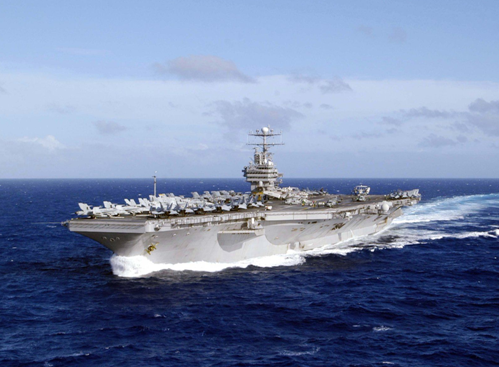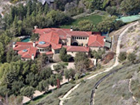
USS Abraham Lincoln (CVN-72)
Wikipedia | 2012-10-17 12:53

USS Abraham Lincoln (CVN-72), is the fifth Nimitz-class supercarrier in the United States Navy. It is the second Navy ship named after former President Abraham Lincoln. Her home port is Norfolk, Virginia, and she is a member of the United States Atlantic Fleet. She is administratively responsible to Commander, Naval Air Forces Atlantic, and, operationally, she is currently the flagship of Carrier Strike Group Nine and host to Carrier Air Wing Two.
Ship history
Lincoln's contract was awarded to Newport News Shipbuilding on 27 December 1982; her keel was laid 3 November 1984 at Newport News, Virginia. The ship was launched on 13 February 1988 and commissioned on 11 November 1989. She cost $4.726 billion in 2010 dollars.
1990 to 1999
Abraham Lincoln was transferred to the Pacific in September 1990 performing Gringo-Gaucho with the Argentine Naval Aviation during her transit. From 4 October, Lincoln formed CTG 24.8 in company with USS DOYLE FFG-39; 6 October transit with USS PAWCATUCK, USS DOYLE in company. Her maiden Western Pacific deployment came unexpectedly on 28 May 1991 in response to Operation Desert Shield/Desert Storm. The ship had the staffs of Commander, Carrier Group Three, Rear Admiral Timothy W. Wright, and Destroyer Squadron 9 embarked, as well as Carrier Air Wing Eleven. She was accompanied by a seven-ship battle group.
While heading towards the Indian Ocean, the ship was diverted to support evacuation operations after Mount Pinatubo erupted on Luzon Island in the Philippines. In support of Operation Fiery Vigil, Lincoln led a 23-ship armada that moved over 45,000 people from the Subic Bay Naval Station to the port of Cebu in the Visayas. It was the largest peacetime evacuation of active military personnel and their families in history. After Fiery Vigil, Lincoln steamed toward the Persian Gulf, to run reconnaissance and combat air patrols in Iraq and Kuwait, assisting allied and US troops involved with Desert Storm. In early 1992, the ship was at Naval Air Station Alameda on Ship's Restricted Availability for minor maintenance and refitting.
From June 1993 Lincoln was the flagship of Commander, Carrier Group Three. In October 1993, the carrier was ordered to the coast of Somalia to assist UN humanitarian operations. For four weeks, Abraham Lincoln flew air patrols over Mogadishu in support of Operation Restore Hope.
Abraham Lincoln was to be the first carrier to integrate female aviators into the crew after the Combat Exclusion Laws were lifted on 28 April 1993. The ship left San Diego on 24 October 1994, to begin refresher training. The next day, Lieutenant Kara Spears Hultgreen, first female F-14 Tomcat pilot, died when her plane crashed into the sea on final approach due to a combination of engine malfunction and pilot error.
Abraham Lincoln's third deployment began in April 1995 when Lincoln was sent to the Persian Gulf, where the ship assisted in Southern Watch and in Operation Vigilant Sentinel. During an underway replenishment, the Lincoln was run into by USS Sacramento when the Sacramento had steering difficulties due to a split rudder, crushing the port side of the USS Sacramento, crushing the M-frames, partially crushing a female crew berthing area, and punching a large hole in the Sacramento’s superstructure. (TACAN room) The Lincoln was able to continue on with her mission while the Sacramento had to dock at Jebel Ali, U.A.E. for several weeks for repair.
Later that year, a supposed transcript of an exchange between the Abraham Lincoln and a Canadian lighthouse was widely disseminated on the Internet. The Navy has officially denied it occurred, but it continues to circulate.
2010
On 13 January 2010, the carrier completed upgrades and repair that cost $250 million at Puget Sound Naval Shipyard. The carrier was to be assigned to Carrier Strike Group Nine. On 3 February 2011, The ship was awarded the Battle Effectiveness Award for its high standards of excellence and combat readiness.
On 9 December 2010, the U.S. Navy officially announced that Naval Station Everett, Washington, was the new homeport for the USS Nimitz (CVN-68), replacing Abraham Lincoln, which would be undergoing its scheduled Refueling and Complex Overhaul (RCOH) at the Northrop Grumman Shipbuilding-Newport News shipyard in Virginia which is slated to begin in 2013.
2011
On 1 March 2011, the news media reported that the U.S. Navy had awarded Northrop Grumman Shipbuilding-Newport News a $206.7 million USD option under a previously awarded contract to plan Abraham Lincoln's RCOH. The planning contract covered the design, documentation, engineering, advanced material procurement, inspections, fabrication, and support work for Lincoln's RCOH, with more than 1,000 employees supporting this planning phase. Additional funding for the RCOH was pending the passage of the U.S. Department of Defense's Fiscal Year 2011 budget appropriations by the U.S. Congress. Upon authorization, the Lincoln's RCOH was anticipated to begin in 2013, and it is scheduled to take between three and four years to complete at an estimated overall cost of $3 billion USD.
In addition to the refueling of its two A4W nuclear reactors, Abraham Lincoln's upcoming RCOH will include the installation of the newly developed Advanced Arresting Gear (AAG) system. Developed by General Atomics, the AAG system will replace the Lincoln's current Mark-7 arresting gear’s hydraulic machinery with an electric motor-based system. The new system offers greater operational flexibility, reliability, and safety with reduced manning and maintenance costs. The AAG system is standard equipment for the upcoming Ford-class supercarriers. Abraham Lincoln is the first Nimitz-class supercarrier to have the AAG system retro-fitted with other Nimitz-class carriers also to be so retro-fitted during their upcoming RCOH yard period.
On 1 August 2011, the U.S. Navy announced that the Abraham Lincoln will shift its homeport from Everett, Washington, to Newport News, Virginia, for its Refueling and Complex Overhaul in August 2012. The ship departed Everett for the deployment that would take it around the world to Newport News in December 2011.
2012
On 22 January 2012, the U.S. Navy announced that Lincoln had entered the Persian Gulf "without incident." The deployment through the Straits of Hormuz came at a time of escalating tensions with Iran. The Lincoln, accompanied by a strike group of warships, was the first U.S. aircraft carrier to enter the Gulf since late December 2011 and was on a "routine rotation" to replace the outgoing USS John C. Stennis.
The departure of the Stennis prompted Iranian army chief Ataollah Salehi to threaten action if another carrier passed back into the Gulf, saying, "I recommend and emphasize to the American carrier not to return to the Persian Gulf. ... We are not in the habit of warning more than once,"
Lincoln transited the Suez Canal northbound on 16 July 2012 and the Strait of Gibraltar on 26 July 2012 en route to the United States. On 7 August 2012, Lincoln arrived at Norfolk Naval Station following an eight-month deployment to the U.S. Navy's 5th, 6th and 7th Fleet areas of responsibility, in preparation for her Reactor Complex Overhaul at Newport News.
Share this page



















